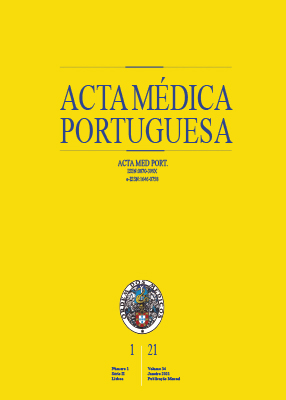O Impacto a Longo Prazo da Síndrome Pós-Trombótica Numa Coorte Retrospetiva no Norte de Portugal
DOI:
https://doi.org/10.20344/amp.13567Palavras-chave:
Insuficiência Venosa, Qualidade de Vida, Síndrome Pós-TrombóticaResumo
Introdução: A síndrome pós-trombótica é uma complicação frequente da trombose venosa profunda, contudo a incidência em Portugal é desconhecida. O principal objetivo é determinar a incidência e gravidade da síndrome pós-trombótica após primeiro episódio de trombose venosa profunda.
Material e Métodos: Estudo de coorte observacional, unicêntrico e retrospetivo de doentes com primeiro episódio de trombose venosa profunda do membro inferior documentado por eco-doppler (n = 101). O score Villalta modificado foi aplicado por entrevista telefónica para diagnóstico e categorização da síndrome pós-trombótica. A qualidade de vida dos pacientes foi avaliada pela classificação CIVIQ -14 ajustada.
Resultados: A mediana do tempo de seguimento foi de seis anos. A síndrome pós-trombótica grave esteve presente em 27% e
moderada em 33%. A prática de atividade física no momento da entrevista esteve associada a uma menor incidência de síndrome
pós-trombótica (risco relativo = 0,489; intervalo de confiança de 95% = 0,320 - 0,748). O aumento de peso após trombose venosa profunda (risco relativo = 2,188; intervalo de confiança de 95% = 1,137 - 4,210) e menores habilitações literárias (risco relativo = 2,005; intervalo de confiança de 95% = 1,297 - 3,098) revelaram associação positiva com síndrome pós-trombótica. A qualidade de vida correlacionou-se com a síndrome pós-trombótica, sendo 90 ± 17, 64 ± 18 e 43 ± 15 em doentes sem síndrome pós-trombótica, com síndrome pós-trombótica moderada e com síndrome pós-trombótica severa, respetivamente (p < 0,001).
Discussão: Nesta coorte de doentes no Norte de Portugal, a incidência a longo prazo da síndrome pós-trombótica é superior a outros estudos e correlaciona-se com piores resultados na classificação CIVIQ-14 ajustada.
Conclusão: Estudos prospetivos são necessários para maior evidência.
Downloads
Downloads
Publicado
Como Citar
Edição
Secção
Licença
Todos os artigos publicados na AMP são de acesso aberto e cumprem os requisitos das agências de financiamento ou instituições académicas. Relativamente à utilização por terceiros a AMP rege-se pelos termos da licença Creative Commons ‘Atribuição – Uso Não-Comercial – (CC-BY-NC)’.
É da responsabilidade do autor obter permissão para reproduzir figuras, tabelas, etc., de outras publicações. Após a aceitação de um artigo, os autores serão convidados a preencher uma “Declaração de Responsabilidade Autoral e Partilha de Direitos de Autor “(http://www.actamedicaportuguesa.com/info/AMP-NormasPublicacao.pdf) e a “Declaração de Potenciais Conflitos de Interesse” (http://www.icmje.org/conflicts-of-interest) do ICMJE. Será enviado um e-mail ao autor correspondente, confirmando a receção do manuscrito.
Após a publicação, os autores ficam autorizados a disponibilizar os seus artigos em repositórios das suas instituições de origem, desde que mencionem sempre onde foram publicados e de acordo com a licença Creative Commons









